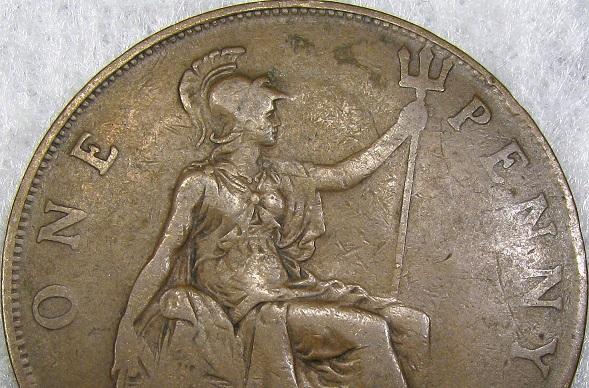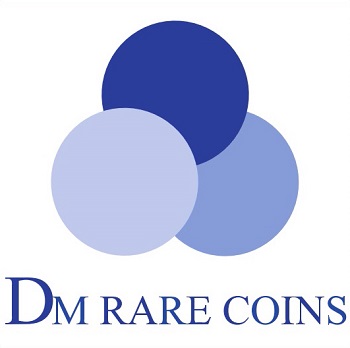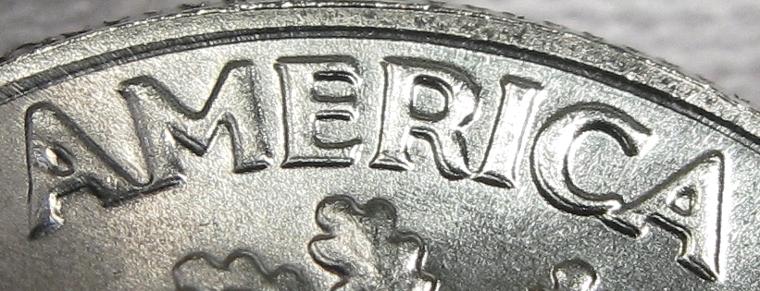Welcome to Our Blog!
Years 2016 - 2015
Find useful information, announcements, coupons, anecdotes, market reports, an educational Coin of the Month, and musings not suitable for our Research section.
December 31, 2016
DM Rare Coins Coin of the Month
December 2016
1971-D Eisenhower Dollar
NGC MS65 Prooflike
Prooflike Eisenhower dollars that qualify for the strict Prooflike designation of NGC are very rare. Until this month, only a few Ikes had been certified as Prooflike, all of which were 1976-D Bicentennials. The present 1971-D Prooflike Eisenhower dollar is a new discovery and the only Prooflike Ike of the non-Bicentennial, regular design that has been certified to date. Its exceptional mirrors and field clarity are to thank.
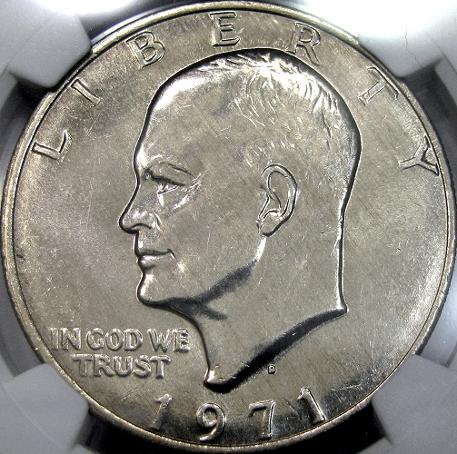
The NGC Prooflike population
is as follows:
1971-D: 1
1976-D Type 1: 3
1976-D Type 2: 1
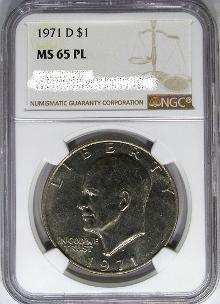
The Prooflike designation awarded to this lonely 1971-D Eisenhower is extraordinary when considering that collectors have long documented the existence of 1971-D Ikes that display unusually glossy surfaces. This body of coins has occasionally been referred to as “Prooflike” by specialists, but none of them have previously made the strict standards of the NGC Prooflike designation. As of this publication, NGC has graded some 2853 Business Strike, 1971-D Ike dollars, and only now has one surfaced in Prooflike. Another interesting metric to examine is the percentage of Prooflike Ikes, across the entire series, including P-Mint, D-Mint, and 40% silver S-Mint coins. NGC has graded 5 Prooflikes out of 74,591 Ike dollars, or just 0.000067%! (NGC)
The present coin is extra special because of its unblemished
field texture. To make Prooflike at NGC, a coin needs to have a continuous,
highly reflective field surface on both sides. Most of the reflective 1971-D
pieces we have seen have demonstrated extreme, mint-made surface interruptions
that rendered otherwise-qualified coins incapable of achieving the Prooflike
designation. Both planchet tumbling marks and grease strike-through
roughness can cause a coin not to designate, and these mint-made anomalies are ubiquitous on Ike dollars. Coins without them are few and far between.
Most of these reflective 1971-Ds still fail to designate, even when
the fields are smooth. The reason for this is that most are only semi-reflective and not
truly Prooflike. Not only do the mirrors of a true Prooflike have to be
unbroken, but they must also show a crisp reflection from between 2-4 inches
away from the face of the coin. The mirrors on the majority of observed
specimens, blemished or clean, to not achieve this level of depth. The present
piece is both clean and deeply mirrored, and that combination was the key to it
becoming the first Prooflike 1971-D.
Finally, it is also worth noting that our present Coin of the Month was not only produced with above average qualities, but it also happens to survive in gem condition. Bag marks do not typically preclude a coin from the Prooflike designation, but they can be more distracting on mirrored surfaces than on frosty surfaces, resulting in lower grades than their frosty counterparts might receive with the same surface impairments. This piece made Gem Prooflike; thus the only known Prooflike of 1971-D proves to be a fine representative of this rare issue.
NGC Census: https://www.ngccoin.com/census/united-states/dollars/51/
Happy Collecting!
Doug
DM Rare Coins
December 2, 2016
Interesting Question We Recently Answered:
"Hi, I have a 1964
D Type C Reverse Washington quarter that is graded by ANACS and it has FS-902
on the label. What does the FS-902 mean? All of the other 1964 D Type C Reverse
quarters that I see graded by other coin grading companies have a FS-901 on the
slab labels....(No other coin dealers that I have talked to seem to know.)
Thanks, Jeff"
Hello, Jeff,
This anomaly seems to stem from an error in an earlier edition of the Cherrypicker's Guide. Originally, the FS-901 designation was reserved for the Type B 1964-D quarters that were believed to exist, and so the CPG then used FS-902 for Type C 1964-D quarters. However, in actuality, the Type B reverse appears only on P-mint quarters, and the Type C reverse appears only on D-mint 1964 quarters, so there was no need to use a 902 on 64-D. In the current Cherrypicker’s Guide, the 1964-D Type C has been re-designated as FS-901 (page 216), and the retired 1964-D FS-901 and FS-902 numbers are listed in the index (page 478).
November 2016
1976 Washington Bicentennial Quarter
"Monster Rainbow" Clad!
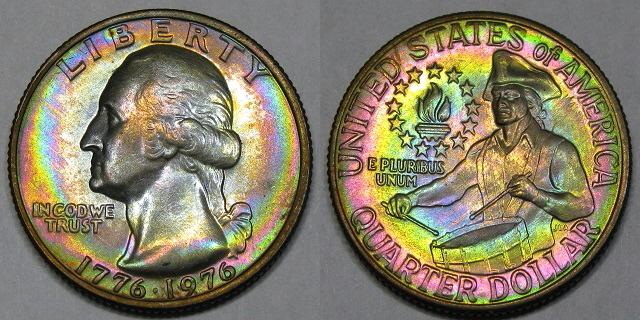
The clad coinage put out between the 1960s and 1980s has, over many years in sulfurous albums, rolls, and mint packs, now begun to develop patina with some regularity. Collecting colorful examples of clad coinage is a relatively new phenomenon, but it has been made popular by books like Rick Tomaska’s Kennedy half dollar book, which features some colorfully toned, clad Kennedy halves.
From time to time, we have handled some of these colorfully toned clad coins, but we were not prepared to see this one. The featured 1976 clad, bicentennial quarter is, without question, the most gorgeously toned clad coin we have ever seen. We do not use the term “monster” lightly, but I think most would agree that coins of this quality are the reason for that term’s existence in the context of coin collecting.
This sharply struck and satiny gem is lined on both sides with exquisite neon concentric rings of rainbow color. Not to get off on a tangent, but there are some who take offense at the overuse of the term “Rainbow Color,” and it is generally a good thing to keep such modifiers in check. However, the present piece is not only a textbook monster, but also embodies the very definition of rainbow toning.
While this piece is not in our inventory; and frankly, we do not anticipate to be able to locate anything else quite like it in the near future; you should keep on the lookout for colorfully toned clads, yourselves. You may just come across your own monster!
Doug
DM Rare Coins
DM Rare Coins Coin of the Month
October 2016
1758 "Goree Taken" Great Britain Medal
Medallic Illustrations 691-415
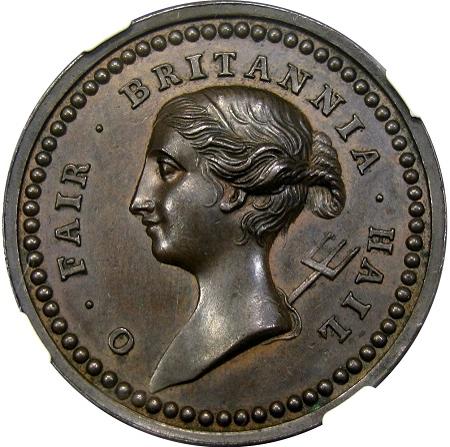
"Goree is a tiny island just off the West African coast of Dakar, Senegal. Goree Island was a Dutch plantation until it was captured by the French during their empire-building of the 1670s (Medallic Illustration, 691). With full command of Dakar Harbor, the fortified outpost protected the lucrative shipping trade of greater Senegal. In modern times, it has become associated with the African Slave Trade, but there is debate over what role Goree Island itself played in that ugly business. It was primarily a military instillation in the 18th Century, which helped control the overall trade of Senegal (Wikipedia).
During the Seven Years War and French and Indian War, 1754-1763, the British government became aware of the advantages both of taking Goree from the French, and of holding it for their own benefit."
Read our full, feature length article: Goree Taken 1758: An Obscure British Victory that Changed The Course of History.
The present medal is a rare relic of that global conflict above mentioned, and one that won awards for its design and execution back in the 1750s. And with superb, with smooth, chocolate brown patina and no obvious marks or corrosion, this piece could win awards today for its quality. Few of these Goree Taken medals, and their sister medals, of the Louisberg Taken variety, survive today. This was an obvious choice for our Coin of the Month blog. In fact, it spawned a feature length article.
Excerpted:
"The edge of the Goree Taken medallions is lettered with one of two inscriptions. A precious metal copy was given to William Pitt, which read “William Pitt Administring [sic];” another was presented to Admiral Keppel, which read “Augustus Keppel Commanding;” and copper medals were available to the general public with either edge inscription (MI, 691). The present Choice Uncirculated representative, in copper, and possessing the William Pitt Administring edge inscription, is sharply struck and in a remarkable state of preservation for a medal of this era"
Bibliography
Anderson, Fred. Crucible of War. The Seven Years War and the Fate of Empire in British North America, 1754-1766. First Edition. Vintage Books. New York; 2001 (p.305-306).
Betts, Charles Wyllys. American Colonial History Illustrated By Contemporary Medals. Ed. William T. R. Marvin A. M., Lyman Haynes Low. New York, Scott Stamp And Coin Company, Limited, 1894 (p. 185).
Medallic Illustrations of the History of Great Britain And Ireland to the Death of George II. Vol. II. Ed. Edward Hawkins, Augustus W. Franks, Herbert Grueber. London; Longmans and Company, 1885 (p. 688, 691).
Orme, Robert. Winthrop Sargent, M.A., ed. The History of an Expedition Against Fort Duquesne, in 1755; Under Major-General Edward Braddock. Philadelphia; Lippincott, Grambo & Co. for the Historical Society of Pennsylvania, 1855.
“The World Ablaze: An introduction to The Seven Years War.” Fort Ligonier Museum. 200 South Market Street, Ligonier, PA 15658; 2016. Special thanks to Fort Ligonier, which displays of an exhibit on the campaigns of West Africa and Goree Island, including the original 1760, George III, Governor of Goree appointment.
Wikipedia; Goree. https://en.wikipedia.org/wiki/Gor%C3%A9e. October 22, 2016.
Doug
DM Rare Coins
Dm Rare Coins Coin of the Month!
September 2016
1944-D Walking Liberty Half Dollar
Hand Engraved Designer's Initials FS-901
PCGS MS66+
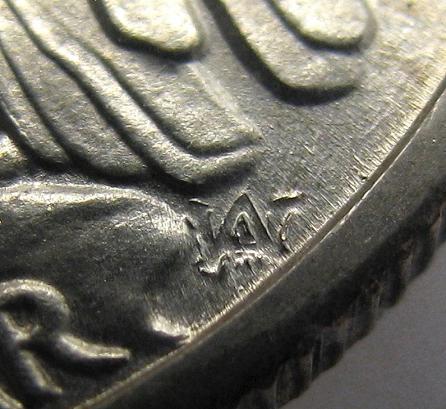
There are several strange varieties that affect the designer’s initials on the beloved Walking Liberty half dollar series. Sometimes the AAW anagram was polished away, creating the popular no AAW varieties. Yet there is another variety that seems even more curious. A single 1944-D reverse die shows a hand-engraved AW and has been recognized with an FS-901 classification by the Cherrypicker’s Guide.
For those who are not familiar with modern minting practices; all the details of the die, from busts, to lettering, to stars or symbols, to designers initials; are impressed into the die steel by a single hub which contains all of those features. Therefore, it makes no sense to have a Walking Liberty half dollar that does not have an AAW. For this reason, and through studies of die state progressions, we know the various “Missing AAW” varieties are the result of the anagram being polished away.
But what accounts for an AAW that is hand-engraved, and quite literally looks like someone hacked it into the die? It could be that the anagram was damaged or filled on the hub that created this die, or that the die was polished and the originally hubbed AAW was weakened such that mint workers decided to strengthen it. In the Mid-20th Century, there are actually quite a few examples of re-engraved design elements on U.S. coinage, including both Proofs and business strike issues. For example, the Cherrypicker’s Guide lists re-engraved tail feathers for some 1950s Washington quarters. The Mint was always trying to get as much life out of the dies as possible. A study of this variety in various die states would be necessary to determine if this die was used prior to the hand engraving, or if it was that way from its creation. The few pieces we have handled seemed to be in a mid to late die state, but earlier impressions could very well exist.
The present example makes our September, 2016, Coin of the Month, not only because of its popularity and intrigue, but also because of its exceptional state of preservation. This variety has proven to be fairly common in lower grades, but this is the only MS66+ graded by PCGS, and there are just 11 finer, all MS67. Thus it is a conditional rarity and a great example to showcase this cool variety.
Doug
DM Rare Coins
August 9th, 2016
2016-W Gold 100th Anniversary Mercury Dimes:
An Opportunity Missed
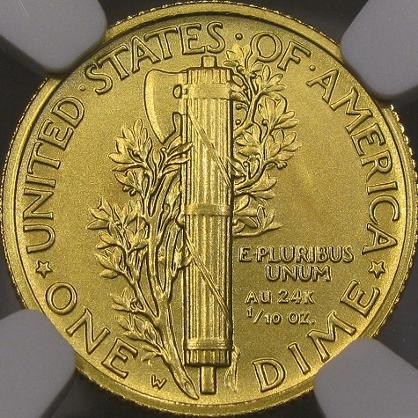
After examining a few of these widely hyped and, admittedly exciting new coins; and speaking to a few collectors who have also seen the new coins; it is clear that the Mint missed an opportunity with this issue. In this age of remakes, and sequels, it is not surprising that all we can do today is mimic the past. And keeping that in mind, I think many collectors, myself included, actually looked forward to the 2016-W Gold Mercury's as an exciting opportunity. The finished coins, however, are a mere shell of the glory of the original design, and the finish is both distracting and inadequate to display the motifs tastefully.
After I saw a few of these, I predicted, before asking anyone, that Mercury dime enthusiasts would be disappointed to see that the bands on the reverse have been more or less erased on the new design. Mercury dime collectors often look at the bands before anything else, and since these coins do not have splits in the bands, a major element of the original design is missing. However, the bands were not the only features lost. Much of the design has been similarly simplified, stylized, and almost abstracted. The hair lines and feathers on the obverse have become indistinct, where the original design shows crisp features and sharp, beautiful details.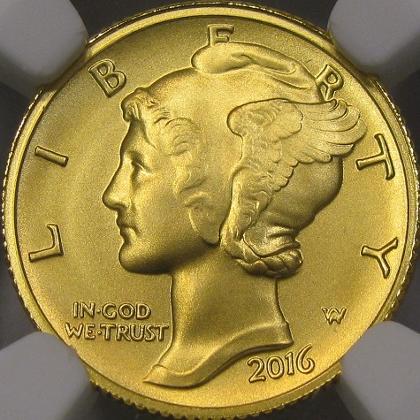
Some of this blurriness can be traced to the finish of the new coins. The brilliant finish of classic, business strike Mercury dimes has been replaced by a swirling, satin finish of the kind the Mint received ridicule for creating on Mint Sets from 2005-2007. The matte contour shows the very strokes of a sandblaster, dominating the appearance and drowning out the motifs, as they cross over both design elements and fields indiscriminately. A classic Proof finish or even a brilliant finish, like that of the original issue, would have better accentuated the design, by leaps and bounds.
It is easy to see why these coins have slumped in price. One
can purchase a perfect 70 (PCGS or NGC) for under $300, today, from a myriad of
online sites, due to tepid enthusiasm with the product. Everyone seems to want
one until they have it; the bullion aspect is the only thing these still have going for them. Hopefully the Mint will learn from its mistakes as they
are putting the finishing touches on the upcoming Standing Liberty Quarter remake; but I'm not holding my breath.
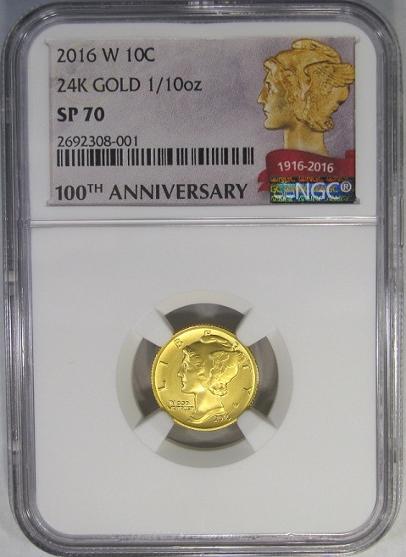
Happy Collecting!
Doug
DM Rare Coins
June 15th, 2016
DM Rare Coins Coin of the Month
June 2015
1776 Great Britain Maundy 1P:
An Amazingly Small Coin
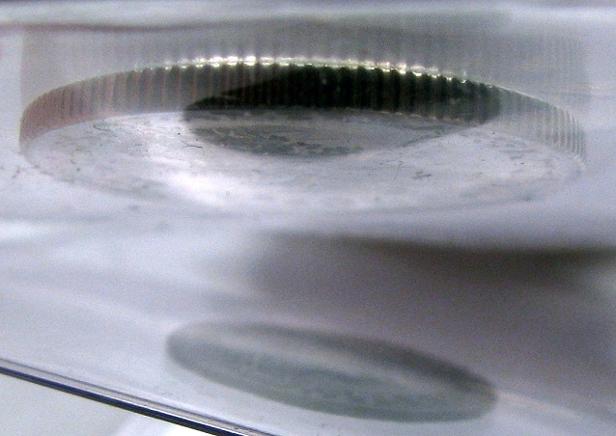
The pictures are somewhat grainy because they were quick snapshots taken some half a dozen years ago, but they make for a cool comparison, still. It is absolutely amazing that paper thin silver coins can survive from the 17th and 18th Centuries, undamaged, let alone in mint condition. The featured photograph is actually a shot of the 1776 Maundy 1P and a 1942-S Mercury dime, one in each pocket of a 2x2 flip. We originally posted this picture on the NGC forum some years ago, where members were asked to guess what the two coins were. Some observers were sure the top coin was a Morgan dollar and the bottom a Lincoln cent, as the tiny US dime actually looks massive in relation to a Maundy 1P.
It was primarily British copper and Spanish silver that circulated in Early America, and so I personally had never paid close attention to the more obscure British silver coinages, prior to handling this raw, 1776 Maundy silver 1 Penny in-hand. And, while this issue is somewhat of a departure from our normal field of study, the extremely small size and fabulous, choice Mint State condition sparked my interest, nonetheless. It is something every collector needs to see in person.
By the reign of Charles II, the minor denominations of 1 Penny and below were being coined in copper. However, some special issues, such as the Maundy Money, issued as a gift to the Poor, were struck in silver. A complete Maundy set contained four silver coins, from 1P to 4P, and its issue was a popular custom from the Reign of Charles II, onward. After George III, however, Maundy sets became more of a collectable than spending money, and only circulated infrequently.
The extremely small amount of silver that equaled 1 Penny in the 1670s contributed to the extremely unwieldy and diminutive size of the Maundy 1P issue, which remained tiny through the course of its production into the 2000s. Each of the prevailing denominations, 2P, 3P, 4P, are literally 1 penny’s worth larger in weight, so that the next smallest coin, the 2P, is exactly twice the size of the miniscule 1P.
This coin went on to grade NGC MS63. I believe we picked it up from a coin show dealer for about $35, so it is quite an affordable issue, despite relative rarity. Go out and find one of your own, and marvel at its small size. Make sure you have ample magnification, too. Engravers tended to make rather egregious mistakes on these tiny dies, so there are some cool varieties to look for.
Happy Collecting!
Doug
DM Rare Coins
May 31, 2016
DM Rare Coins Coin of the Month!
May 2016
1739 Admiral Vernon Fort Chagre Medal. Adams FCv-1A
Undocumented Composition: Brass-plated White Metal
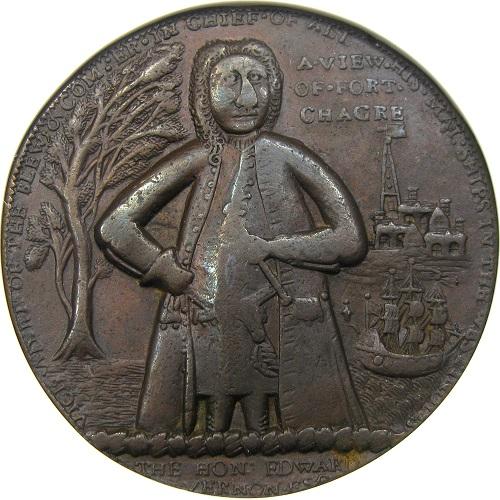
This is a pleasing, problem-free example of the issue, which is a Rarity 5 (31-75 known). Sharply struck from fresh dies, on a good planchet, and free of corrosion. Luster in protected fields serves to contrast against the high-relief designs. All the trimmings to make for a pleasing, circulated Admiral Vernon medal. That said, the most interesting thing about this piece; and the reason it has been selected as our Coin of the Month, is because it is made from a previously unknown metallic composition.
The most recent and most comprehensive catalog of Vernon Medals is John W. Adams' 2010 work, Medalic Portraits of Admiral Vernon: Medals Sometimes Lie. This variety, Adams FCv-1-A (Fort Chagre Vernon, Obverse 1, Reverse A) is known to be struck in solid copper, brass, bronze, and gilt copper. The present specimen is actually struck in white metal (probably a low-grade pewter) and plated with copper or brass. While some Admiral Vernon Medals are known in solid pewter, plated pewter is heretofore unknown in the series, and unlisted anywhere in Adams.
At first glance, the plating appears to be copper, with red iridescence in the fields. Underlying pewter shows through on the reverse high points, where the designs have received enough wear to break through and confirm that this piece is not solid copper. However, we think it might actually be a brass plating, for several reasons.
First, the reason to plate a medal would be to produce it more cheaply, and there would be more to gain by plating a pewter medal with golden brass than there would be to plate it in copper. Pinchbeck brass had a distinctive golden hue and was used extensively on Vernon medals to give them the glow of precious metal. However, it was very expensive compared to other metals, and this expense could have lead to experimentation with plated pewter examples, such as the present specimen. Pewter, of course, is a low grade lead and tin mixture that would have ranked at the bottom of the expense chart. Second, the worn obverse designs show clear evidence of the blue-green hue that develops on brass as it oxidizes, due to its zinc alloy. And third, there are a few tiny patches of golden brass still visible on the obverse below Vernon's portrait. Some 276 years ago, this piece very well might have resembled gold, due to its Pinchbeck plating. The proprietary Pinchbeck alloy was known to contain a higher amount of copper than typical brass, and this could help explain the red hues (Adams, 207). This is what real antique brass looks like, home improvement stores!
Whether the plating is copper or brass, a find like this is unusual and exciting. Again, Adams does not speak of any brass-plated pewter Vernon medals, of any design. Of solid pewter medals in general, that they are found only "occasionally" (Adams, 207). However, in the greater scheme of things, this piece is not entirely unexpected. We know relatively little about who actually produced these medals, let alone the criteria used to determine the standards of metallic composition. This piece does make one wonder how many seemingly solid brass or copper Admiral Vernon medals might actually be plated pewter. If the plating has remained intact, this could be very difficult to determine without advanced scientific equipment. Get out your metal analyzers and specific gravity tests, scientists.
Bibliography
Adams, John W., Dr Chao, Fernando. Medallic Portraits of Admiral Vernon: Medals Sometimes Lie. Gahanna, OH: Kolbe & Fanning Numismatic Booksellers, 2010. p141, 207.
Happy Collecting!
Doug
DM Rare Coins
May 30, 2016
Remembering all those who died in the service of
our country....
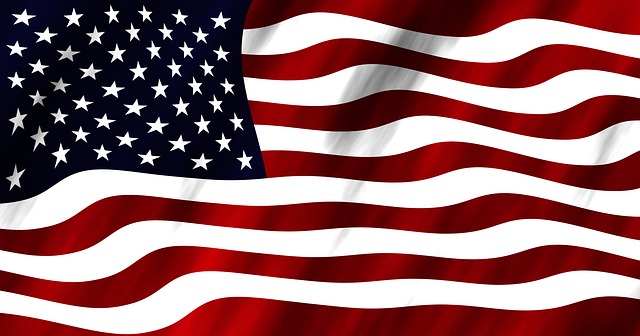
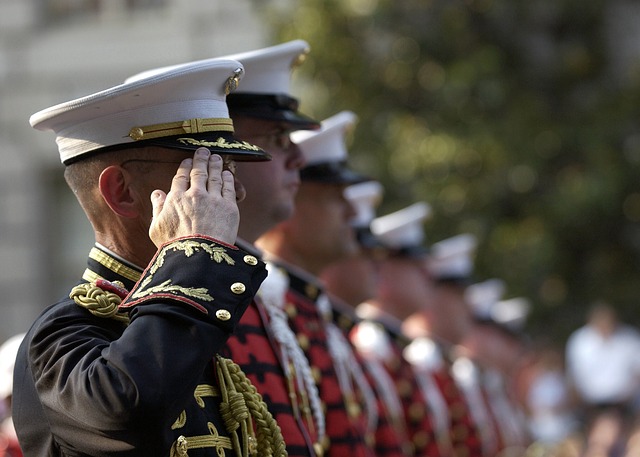

April 30, 2016
DM Rare Coins Coin of the Month!
April 2016
Rare Prooflike War Nickel ~ 1943-S NGC MS66 5FS PL!
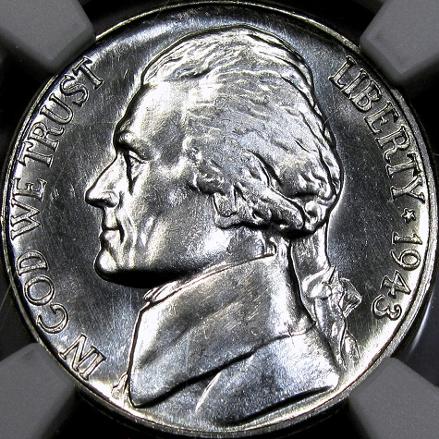
Despite strong mintage figures, often into the hundreds of millions, only a handful of the 35% silver War Nickels, issued from 1942-1945, have been found with Prooflike qualities. Most uncirculated War nickels are heavily frosted or very satiny, with nothing resembling Prooflike qualities. That said, it is not possible to say just how many Prooflike War Nickels might have been minted because these coins were workhorses of the economy and most were placed into circulation almost immediately.
The surviving sample that numismatists must rely on consists of only those coins saved at random in uncirculated rolls; and yet, enough were saved that we can still discern a pattern in the appearance of Prooflike coins. As with other denominations during the 1934-1954, Polished Prooflike period (which we have discussed before, at great length), virtually no Prooflike coins are found from the Philadelphia Mint, and a majority emanate from San Francisco. NGC census data reveals that all known, Prooflike War Nickels were struck at San Francisco. 1942-S has a population of 11 coins, with just one in 5 Steps Prooflike. The featured 1943-S date has a total population of four coins in Prooflike, including two in 5 Steps Prooflike. None have been graded for 1944-S, and just one coin has been graded PL for 1945-S, which is not a Full Steps coin. (NGC).
Thus, only three War Nickels are graded 5 Steps Prooflike, and all three happen to grade MS66. The present 1943-S is then tied with a single 1942-S and one other 1943-S as the finest known Prooflike War Nickel. The strike is impeccable, and the steps are sharp. The fields are moderately mirrored with ample watery reflectivity throughout, and the high points are slightly frosted, especially Jefferson's home, Monticello. While the outward appearance of the finish at first seems like a more traditional, smooth, watery Prooflike surface, close inspection does reveal traces of the granite-like striations unique to the 1934-1954 Prooflike ere, simply in a smaller grain.
Bibliography
NGCcoin.com/census
Happy Collecting!
Doug
DM Rare Coins
April 1, 2016
It's Tax Refund Season!
Enjoy a Special Promo from DM Rare Coins!
It's Easy!
Purchase $500 in coins from our website in April of 2016 and
Receive a $50 Gift Certificate Coupon to use on a future purchase before 12/31/16.
- You must mention Tax Promo in the note section of your checkout page.
- Certificate has no cash value
- Cannot be combined with any other coupon
- Valid on future orders only, not valid on current or existing purchases, or negotiated items
- The minimum order amount must be $50.00 to redeem the certificate (should be easy).

What's not to love about earning $50.00 in free stuff?
Happy Collecting!
Doug
DM Rare Coins
March 31, 2016
DM Rare Coins Coin of the Month!
March 2016
1946-S Prooflike Obverse Walking Liberty Half Dollar
CONECA Doubled Die Obverse DDO-001 Discover Piece
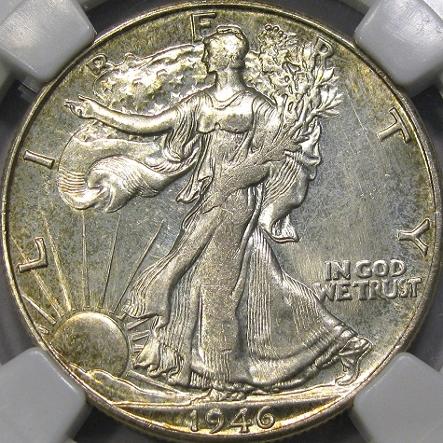
There are many reasons to celebrate the appearance of a coin like this. First, Prooflike Walking Liberty Half dollars are very rare, and the obverse is of the Polished Prooflike type that we have been researching for many years, and about which we have written a couple of articles. Secondly, we sent this piece to CONEA and it became the discovery piece of a new Doubled Die Obverse, Walking Liberty half dollar; 1946 CONECA DDO-001.
This Prooflike Walking Liberty obverse die was paired with a Very Late Die State, heavily frosted reverse die. It seems to have been the MO of the mint workers who employed these mysteriously polished dies to either use them as replacements for well-worn obverses; with no apparent regard for how badly degraded the reverse dies were becoming; or to pair a polished obverse with a polished reverse and make a fully Prooflike coin. That said, we actually have seen a few examples where a polished reverse was paired with a well-used obverse, but that does not seem to have been the norm.
While the gorgeously mirrored obverse earned this coin a Star Designation at NGC, the doubled die is not found in the Cherrypicker's Guide, and so, for the time being, it cannot be recognized on the holder. Such is the case with many great die varieties. 1946-S CONECA DDO-001 shows moderate die doubling, to the south, on the date, the lower drapery edges, and the sandals. We have seen two examples of this issue, and both were similar die states, and both were softly defined in the centers, possibly indicating an improper die spacing. This marriage could not have lasted very long with such a well-worn reverse die, however, the freshly polished obverse, which is the important variety here, could have gone on much longer. It remains to be seen if it can be discovered with a different reverse!
Happy Collection!
Doug
DM Rare Coins
March 15, 2016
Intrigue & Mayhem On the Ides of March; i.e.,
Ongoing Questions About CAC
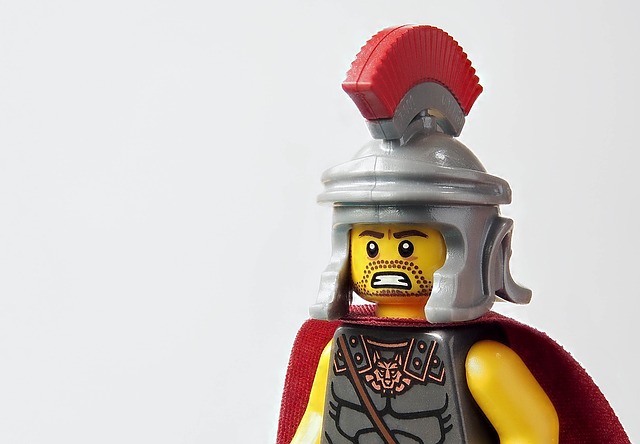
Our number one, most commonly asked coin question in numismatics today is, "Has this coin been to CAC?" Being almost a decade old, by now, most collectors have heard of CAC, and understand that they are a grading service that, in affect, grades the other grading services. CAC places Green stickers on coins that are solid or High-end for the grade, and Gold sticker's on coins that are grossly under-graded, in their opinion. Grading services have made mistakes over the years, and the second opinion of CAC is mainstream now. Even notoriously rigid eBay recognizes that PCGS CAC and NGC CAC designations are a part of life in coins today.
The inquiries we frequently receive are not regarding how CAC works. Instead, they tend to be either CAC enthusiast, wondering if certain coins have been to CAC; or CAC haters, who wonder why we are promoting CAC. Nope, there's no way out of this one, G. Julius....
Firstly, we specialize in high-end coins. Thus, it is likely that a large percentage of our coins will qualify for CAC stickers. However, we typically offer up our freshly graded coins and other new purchases before they are ever submitted to CAC. It takes time to build a cost-effective submission, and the coins will be unavailable for up to several weeks during the process. Also, CAC has a limited scope and will only except certain coins. For example, CAC will not grade silver Roosevelt dimes, 1946-1964, or silver Proof Washington quarters, 1950-1964. They will however accept Clad Ike dollars, 1971-1978, for grading, but not the Proofs (and no, they do not accept Ancients either).
Secondly, being forced to work within the framework of the current market is not the same as promoting the companies that run the market. Our conservative standards have been in use far longer than CAC's existence. Sometimes we will advertise that we have a large number of CAC coins in stock, and receive actual hate mail from people who are against the CAC concept; "Why are you selling stickers instead of coins," or "it is all a scam that you are perpetuating," are the cries of the disenfranchised senators wielding their sharpened blades. Conversely, if we were simply to refuse to submit to CAC, and therefore force our internet buyers to take our word for it that the coins are high-end, we would only receive hate mail for another reason. "You are either an expert or a liar," is one of my personal favorites.
In summary, the majority of collectors want to know whether or not our inventory coins have been to CAC, and coin grading services, including CAC are an integral part of the coin market today. Whether we like it or not, we all have to live, or die, with that reality.
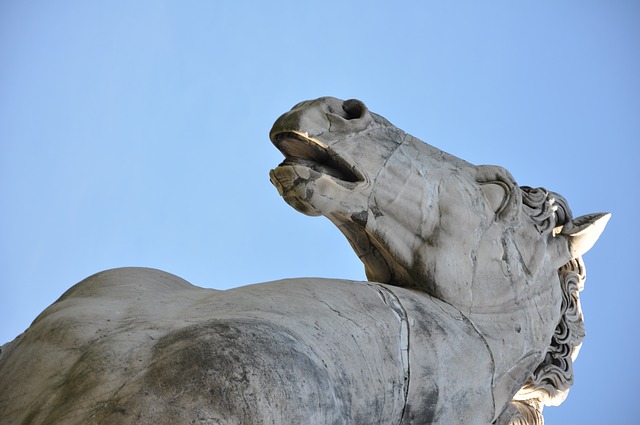
Happy Collecting....It is supposed to be fun! We sure do get a kick out of it....
Doug
DM Rare Coins
February 29, 2016
DM Rare Coins Coin of the Month!
February 2016
1663-Y Madrid Mint Spanish 16 Maravedis (with Rossettes) Copper
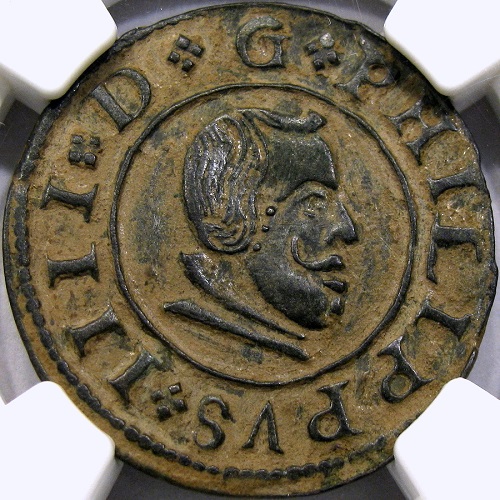
In the 17th and 18th Centuries, commerce, throughout the world empires of England, France, and Spain, was expected to occur without any reliable quantity of small change. When coppers were produced, the quantities were often inadequate to satiate demand across far-flung colonial outposts. Storied 19th Century British coin collector and author, Hyman Montagu, succinctly spotlighted the problem, that “it had always apparently been considered by the reigning sovereigns that the coinage in the inferior metals was a subject beneath their dignity” (Montagu, xx). The British, in particular, never bothered to strike coppers until the reign of Charles II in 1672, and the largest Spanish copper of the period, the 16 Maravedis, which weighed somewhere between a halfpenny and farthing, was only struck from 1661-1664. Spain increased production during the 18th and early 19th centuries, but it was still inadequate to meet global demand. In fact, just as Spanish silver coinage fueled the global economy of the period, Spanish copper also found its way around the world to fill the well-documented shortages in America. Yet, the role of Spanish copper in America is often forgotten, partly because so few pieces survive.
If anyone has seen the History Chanel’s original series, “The Curse of Oak Island,” they may recall that the team found an early Spanish 8 Maravedi on that Nova Scotia Island. Spanish coppers circulated side by side with British pieces in the Americas and elsewhere. Thus, the featured 1663 16 Maravedi and similar pieces are of broader interest and collectability, outside the realm of coins of Spain, coins of Europe, or etc. They are as much coins of the colonies as they are European. This early copper should then be of great interest to Early American collectors. However, its broad appeal is not the impetus for making it our February 2016 Coin of the Month. That impulse stems from its exceptional quality.
By definition, copper that is around 350 years old is usually not found in good condition, due in part to the toll taken by the elements, but also due to impurities in the metal. The original patina on this piece has protected it from the elements, prevented the typical porosity and corrosion, and this coin had the good fortune of being struck on a choice planchet, of good metal.
The earliest Spanish Maravedi coins were by no means heavily produced, nor were they well-made; and with heavy circulation around the globe, very few survive in problem free condition. Moreover, many of them started out with major flaws. First of all, the dies were hand punched using rather primitive, hand-carved punches. Then the coins were struck using somewhat primitive rocker presses, which did not exert enough pressure to strike the coins completely with a single blow; instead requiring the dies to be rocked around a pivot point in order to impress the entire planchet with a design. By necessity, the planchet had to be made extra thin, (this piece is roughly the thickness and size of a large-size Capped Bust quarter) and the resulting emission comes out with a bowed or slightly conical shape. It is typical for the coins to be very weakly struck, double struck, off-center, or even showing lines of flat strike through the designs, where the dies did not make proper contact. This aggressive striking technique makes it easy to see how such a thin copper planchet might become torn, cracked, or otherwise weakened by a stressful and inconsistent process, especially if veins of impurities were already running through the copper, as was often the case.
With the majority of the surviving pieces of this crude issue coming with planchet defects, environmental damage, and off-center or weak strike, the present example is somewhat remarkable, on a number of levels. A quick search of ebay for 1663 16 Maravedis will reveal a plethora of hits for damaged, corroded, and broken pieces that are not eligible for certification. In fact, the featured example is the only 1663 piece ever to be slabbed by PCGS or NGC, and just a dozen or so have been graded for the entire 1661-1664 emission. Virtually un-collectable due to scarcity, values have stayed extremely low, and the frequency of problem pieces serves as an additional blow to general appeal and interest for these coins. Rare exceptions like the present piece are of special interest and added value, when they can be located.
Specifically, the first aspect that sticks out on our featured 1663 16M is the razor sharp strike and exceptional Philip IV portrait. Every detail if the hair, the mustache, and even the nose and facial contours is fully impressed. The lettering is also razor sharp around the rims of both sides, and the high points are lustrous, almost unworn, and stamped in high relief, with no double strike.
That leads us to this cool coin’s next peculiarity; the strike is very well-centered for the type, such that all of its legends are intact. It seems that when these are not found damage, they are instead well off-center, sometimes by 10%-20%, and much of their appeal is lost. In some instances, it appears that mint workers attempted to avoid a planchet tear or mangled planchet void by striking the coin intentionally off-center, in order to miss the problem, rather than rejecting the planchet. With quality standards such as they were, it should start to become clear why this one is special.
Finally, the smooth, lustrous, gunmetal patina over the high points reveals choice copper, and the natural green and brown patina in the fields protects the surfaces and also creates a desirable cameo effect between fields and devices.
This un-conserved,
untouched piece is a marvel. While finding another one
like it seems virtually impossible, surely there are other jewels out there
from this crude, early copper series waiting to be had. If you can find them, they will make for an
exciting and inexpensive doorway into early colonial history.
Bibliography
Montagu, Hyman. The Copper, Tin And Bronze Coinage And Patterns For Coins of England: From the Reign of Elizabeth To That Of Her Present Majesty (1893). Second Edition. Bernard Quaritch; London. 1893. (p. xx).
Happy Collecting!
Doug
DM Rare Coins
February 12, 2016
About Our "Coming Soon" Category
On Lincoln's 207th birthday, we sit here anxiously awaiting the completion and return of some 52 coins from PCGS, which have been lingering there for quite some time now. I want to spin this negative into a positive, and take the opportunity to point out our Coming Soon inventory category. Coins that are already graded and are going to be hitting the broadband soon, but which are nevertheless tied up somewhere, are featured hear. Sometimes, you can actually watch as we build a collection into the system before releasing the coins for general sale! We do accept inquiries and requests on Coming Soon coins, so this category really gives you a great first shot at new purchases.
Just look for this thumbnail on our Inventory page:
Regarding the current PCGS orders; sadly, we have one fresh Lincoln cent to feature this month, but many other coin types are coming, and will appear in Coming Soon as grades become available. If you see something in there that looks or sounds (we may not have coin photography available yet) interesting, contact us asap with your questions and/or reservations.
Among the highlights will be:
- 1853 50C PCGS XF40 DDR FS-801 Seated Liberty Half Dollar ~ Rare & Perfect Original!
- 1922-S $1 PCGS MS64+ Peace Dollar ~ Lovely Golden Mauve Near-gem!
- 1951-S/S 50C PCGS MS65FBL RPM FS-501 Franklin Half Dollar
- 1952 5C PCGS MS65 Gorgeous Two-sided Rainbow Jefferson Nickel
- 1954 50C PCGS PF67 Gorgeously Toned Proof Franklin Half Dollar
- Five Rainbow Toned Clad Kennedy Half Dollars!
- Several more 1970-D DDR Quarters and Dimes in high grades.
Happy Collecting!
Doug
DM Rare Coins
January 31, 2016
DM Rare Coins Coin of the Month!
January 2016
Rare 1838/8 GR-16 Reeded Edge Capped Bust Half Dollar
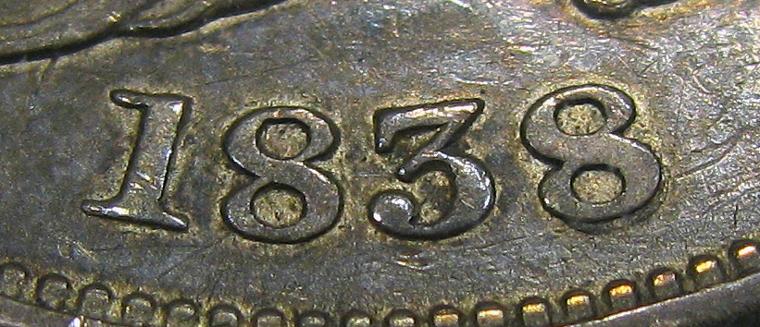
The Reeded Edge Capped Bust half dollar series has been something of an enigma. It ran for just about three years (over four dates), and the production quality was decidedly lax. While the surviving coins tend to be well worn, cleaned, or otherwise damaged, it can even be hard to find Mint State specimens that are pleasing to the demanding collector, due to shortcomings in production. Weak strike, misaligned dies, weak rims, and planchet grease streaks are common. The problems seem to be the result of experimentation at the Mint; the introduction of steam power, close collar technology, full design hubs, and a new, smaller diameter all lead to some major kinks, and it appears that the Reeded Edge half dollars were the test subjects used to iron out those problems.
In addition, two major works have been done on this short series to document die varieties, as it is still possible to identify each die, despite the use of a full design hub (which meant it was no longer necessary to hand punch all the stars and letters). There are many individual die varieties known for each Reeded edge date (except the 1836). Jules Riever put out a variety manual in the late 1980s, and his variety numbers had been used on occasion by some auction companies to describe various interesting varieties and die states. More recently, in 2012, the Reiver system was revised and published into an attribution book by Dick Graham; PCGS, NGC, and the auction companies are now actively using Graham-Reiver (GR) numbers to catalog Reeded Edge Capped Bust halves (NGC).
Among these various varieties are two recut dates; despite a full design hub, the dates were still hand engraved with punches. This was a technique to make full design hubs good for more than one year. An 1837/7, known as GR-6, with a recut upper serif is very common. This variety is easily found on the market, often not attributed. Less frequently encountered, and yet more dramatic, is 1838/8 GR-16, with obverse die showing a boldly recut second 8, with a strong loop showing south east of the primary digit. Having searched high and low for an example of this die marriage for study, we are very pleased to have recently handled one of the three example identified by either PCGS or NGC. Thus, our featured Coin of the Month is a choice quality, PCGS/CAC XF45, with glossy, gunmetal grey fields enhanced by beautiful blue and rose wisps over lustrous fields. The production quality is superb, the preservation is excellent, and the variety is rare.
This is an exciting coin. (As an aside, we would like to take a moment to note that the purpose of our blog, and specifically, our Coin of the Month article, is to educate and not to market inventory. We have yet to feature an item that was part of our inventory. It is possible that a current inventory item could make the spot at some point, but it would be duly noted, and that is not the case here. Actually, we rarely handle Reeded Edge Capped Bust halves in our inventory because so few of them are choice. In other words, enjoy the content, because we are not trying to sell you anything!)
The current population of this variety, in all grades, is PCGS: 1, NGC : 2. The featured example is the only piece graded at PCGS, to date. NGC has graded one XF45 and one MS62. Additionally, unlike 1837 GR-6, we have not seen examples of this variety that were not labeled, though surely there are some out there, being that the Graham-Reiver reference is so relatively recent. Yet, it remains elusive.
References
https://www.ngccoin.com/coin-varieties/subcategory.aspx?subid=25&category=half-dollars&cointype=reeded-edge-half-dollar-die-varieties
Graham, Dick. A Registry of Die Varieties of Reeded Edge Half Dollars 1836-1839. author, Frederick, MD, 2012
Reiver, Jules. Variety Identification Manual for United States Reeded Edge Half Dollars 1836-1839. author, 1988
Doug
DM Rare Coins
January 27, 2016
Time is running out!
You have just 4 days left to Take 5% Off your web order by reading our blog!
Visit our Inventory and use coupon code DMRCBLOG5 at checkout.
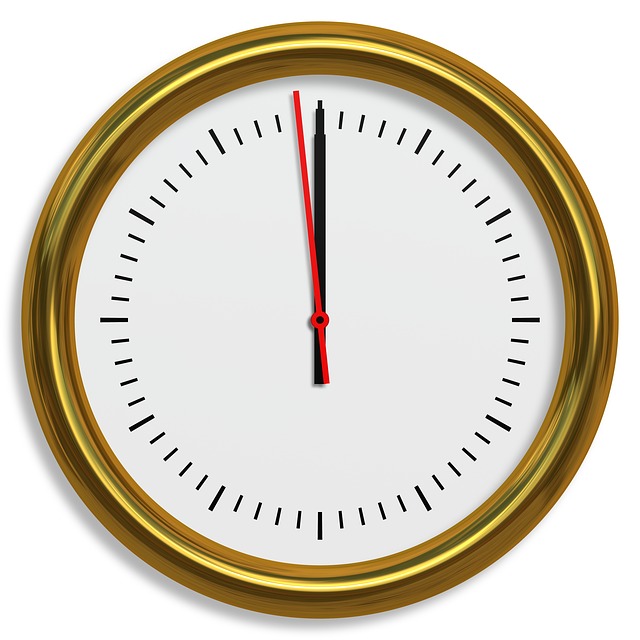
January 24, 2016
New Hoard of 1970-D Doubled Die Reverse
Roosevelt Dimes & Washington Quarters
Reveals Key Diagnostics!
We recently acquired a fascinating and diverse group of high-grade 1970-D Doubled Dies. With many different varieties represented, in a series of different die states, we were presented with a unique opportunity to compare and contrast the notoriously confusing DDR varieties of 1970-D Roosevelt Dimes and Washington Quarters. The comparisons featured the an in-depth article we recently posted on dmrarecoins.com will prove an extremely useful tool for distinguishing between these varieties. Read "The DDRs of 1970-D" Now!
Now that we have finished with them, and being that you now know the differences between them, we will be offering them up on the market, and you may be interested in acquiring some of them. We will be offering a number of high-grade pieces over the next few months. A few of them have already been posted to our inventory, a few more have already been sold, but more coins are coming back from PCGS in the next two weeks.
Enjoy!
Doug
DM Rare Coins
January 8, 2016
Deal Alert!
Enjoy A 5% Off Coupon For Reading Our Blog!
Just use coupon code DMRCBLOG5 at checkout!
Reading the DM Rare Coins Blog has its benefits! We try to fill our posts with informative mini-articles; and hopefully, you are finding them interesting! And now, through the end of January, 2016, we are offering 5% off just for checking them out! However, you must use the coupon code; how else would we know you read it?

December 31, 2015
DM Rare Coins Coin of the Month!
December, 2015
1876 Misplaced Date Seated Liberty Quarter, New Discovery!
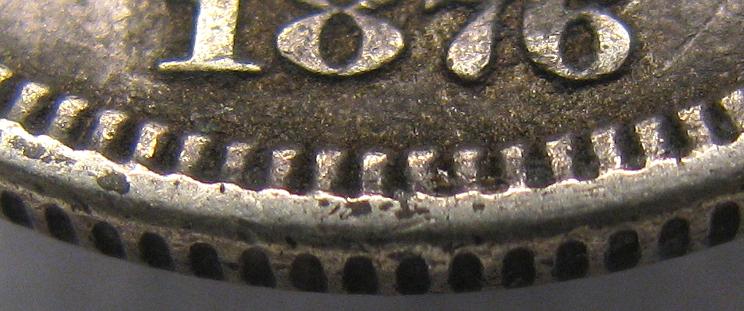
We know what you're thinking, another Seated Liberty makes the December coin of the month. That's two in a row, after the 1853 DDR was featured in November. This quarter was selected because it turns out to be a new discovery, and it is now slated for inclusion in the next Seated Liberty Variety book. The coin is being sent to Kevin Flynn for examination as we speak, and Larry Briggs has already examined the piece.
Seated Liberty, Misplaced Date coins are extremely interesting, as it appears the engravers responsible for applying the number punches to the already-hubbed dies (a topic discussed in more detail on the 1853 DDR post) liked to play around with those punches quite a bit. A number of Seated Liberty issues show arrant digits hidden in rocks, and drapery folds, and dentils.
As for 1876 quarters, an unusually large number of Philadelphia dies seem to have been affected by misplaced digits. Perhaps the engravers were excited for the Centennial celebrations that year and got carried away. A more likely excuse for defacing dies, one that Kevin Flynn has suggested to us, is that the workman needed a place to rest the number punch as they lined up, and they never intended for these anomalies to be found.
At any rate, no less than seven Misplaced Dates have now been found for 1876 Seated Liberty quarters. With numbers like that, they might seem like they would be easy to find; and a few of them have made there way into the Cherrypicker's Guide; but the individual varieties seem to be quite scarce. Some have been given a Rarity-7 rating in specialty publications. The problem of scarcity is further compounded when looking for nicer grades, which are necessary in order to not only identify, but also appreciate these delicate varieties, in the first place.
The featured 1876 Misplaced Date variety clearly shows the top serif of a 7, hidden within the dentils below the date. It doe snot match any other variety yet published. Had it been a lower grade, this feature might have been worn off, altogether.
Doug
DM Rare Coins
December 14, 2015
INTERESTING COIN PHOTOGRAPHY SERVICE ANECDOTE!
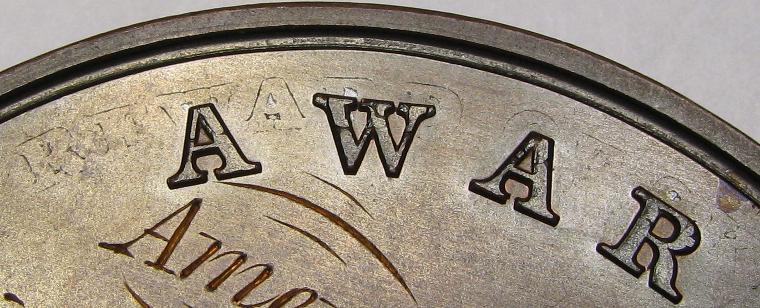
Sometimes a good way examine a coin is through coin photography. Small details can be hard to see under a glass for more than a couple seconds, and sometimes when we photograph a coin, especially one that is not ours, we will notice things that were not immediately apparent, in hand. We recently shot a beautiful Christian Gobrecht, Franklin Institute medal for a customer. While editing the pictures, we noticed a ghost-like image under the imposing, high-relief lettering on the reverse. We pulled the medal back out and took a closer look: beneath AWARDED, were traces of the phrase "REWARD OF SKILL" in a smaller font. This medal was overstruck on a Reward of Skill and Ingenuity medal! Sure enough, the obverse also showed traces of the overstrike as well. Faint ovals dotted the left field; remnants of the hand-engraved, cursive wording on the originally crafted Reward of Skill and Ingenuity under-type. This means the original medal had been both struck and the finishing touches added before being discarded. Perhaps a mistake was made in the hand-engraving and it had to be rejected. Or, perhaps the reward had been revoked prior to presentation. We pointed out this cool find to the owner, who also had not noticed the overstrike. A medal worth perhaps a few hundred dollars is now a unique overstrike with an interesting, albeit unknowable story to tell.
Doug
DM Rare Coins
November 30, 2015
dm rARE cOINS cOIN OF THE MONTH!
November 2015
1853 Doubled Die Reverse FS-801 Seated Liberty Half Dollar
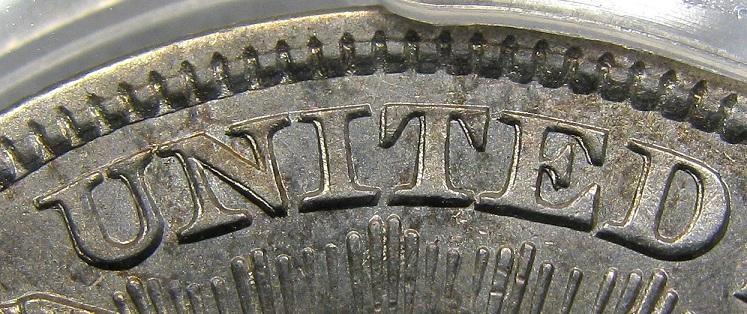
This Doubled Die Seated Liberty Half Dollar remains quite rare and desirable, in any condition. And, as one of the earliest Doubled Die half dollars, it is an exciting find, and a worthy selection for our Coin of the Month spot.
A die is created when a design hub (a raised, steel impression of a coin design) is pressed into the softened die steel to impart an incuse design in to the surface. Before a single squeeze technique was developed by the U.S. Mint in the early 2000s, the hub was often pressed multiple times into the die, in order to bring up the complete design; and Doubled Dies result when the hub turns and the multiple impressions do not line up exactly. Doubled dies show most readily on fine details, such as lettering.
Until the 1840s, most dies manufactured by the U.S. Mint were made principally by hand. A hub containing only the major central design elements was used. Then all the lettering had to be hand punched. Then the die was hand tooled to perfection. This procedure has made Doubled Dies unheard of on Early U.S coinage. But in the late 1830s and into the 1840s, minting techniques were advancing to the point where a complete design hub became standard, and less hand work was necessary. Most hubs included all features accept the date, which was still to be hand punched. (This explains the vast number of re-punched dates listed in the Cherrypicker’s Guide). Doubled Dies started appearing in small numbers.
Only a handful of Doubled Dies are listed in the Cherrypicker’s Guide from the early period, the earliest is probably an 1838 DDR Seated Liberty Dime, and an 1841 DDO Seated Liberty Quarter, and just a few other dies from the late 1840s. While the phenomenon was just starting to become prevalent, it was particularly scarce on larger coins. On half dollars, only two Doubled Dies are listed in the 1840s. The next Cherrypicker’s Guide listings appear in 1853, when the Seated Liberty Half Dollar saw 3 major Doubled Dies. The most dramatic of the three, and perhaps the most dramatic Doubled Die of the Seated Liberty Half Dollar series to this point, is the 1853 DDR FS-801.
The featured example of this rare variety, which was just certified and placed on the PCGS population report this week, is just the 16th piece to be certified, between PCGS and NGC. The Cherrypicker’s Guide notes that the variety shows “a counter clockwise spread on UNITED STATES OF AMERICA, but very little doubling elsewhere” (Fivaz, Stanton, p.252). The doubling on USOM is quite bold, but it is unfair to say that little doubling shows elsewhere; the talons, olive leaves and berries, arrow heads, shafts and veins, the eagles lower feathers, and the word HALF all show moderate doubling. Slight doubling is also visible on the beaded border and sun rays. The doubling is more extensive than that seen on either the 1842 DDR FS-801 or the 1847 DDR FS-101 which came before it; and the other two varieties from 1853, FS-802 and FS-803.
Doug
DM Rare Coins
November 25, 2015
Happy Thanksgiving from DM Rare Coins!
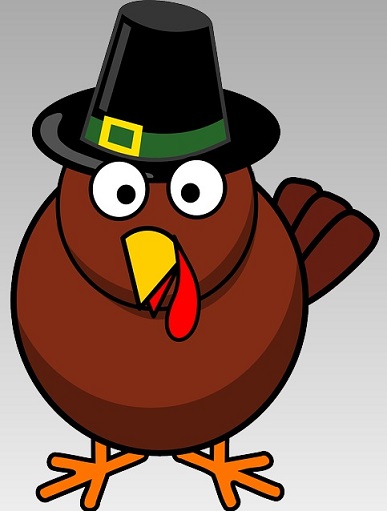
As the Thanksgiving, extra-long weekend begins, we want to wish everyone a great holiday, filled with fun, food, and entertainment from family and friends.
We also want to offer you a special 6% Off coupon on web orders placed between Wednesday 11/25/15 and Monday 11/30/15, Cyber Monday….Mainly because we will not be able to ship any orders out during this time. We already lowered many prices this month on older inventory, which means you are getting a double discount this holiday weekend!
Visit our Online Inventory here ~ Use Promo Code: TURKEYDAY6
Doug
DM Rare Coins
November 25, 2015
The NGC STAR Designation is NOT Just About Eye Appeal
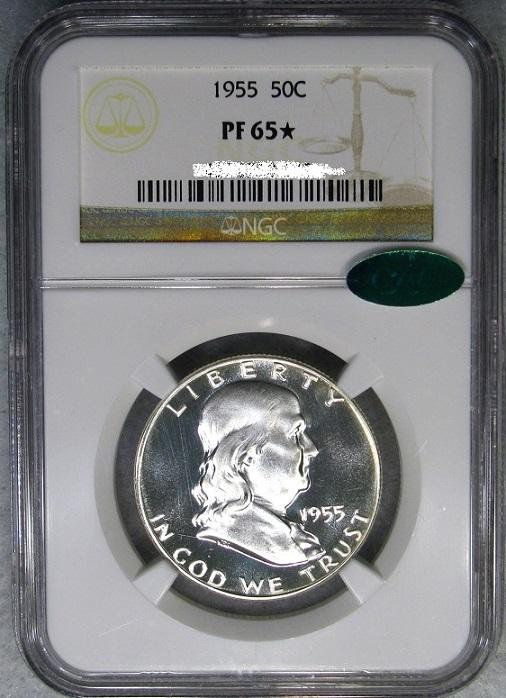
The NGC STAR designation is a great feature developed by NGC to serve essentially as an asterisk next to the grade to denote a special characteristic, i. e., something that sets the coin apart from the typical example. NGC has defined strict parameters on how a coin earns the STAR. However, a constant theme on dealers’ websites, and with collectors posting coins in various forums, is that the “NGC STAR designation was awarded to my coin for great eye appeal.” Yet, there are actually two major categories into which STAR coins fall, and one of them has nothing to do with eye appeal.
Most people equate the STAR with rainbow toning, and NGC states that the STAR is used for coins with “exceptional eye appeal.” Bright rainbow color with the absence of dark spots and muted luster is what they are looking for when it comes to toners. However, many coins are given STARs due to PL, DPL, CAMEO, or ULTRA CAMEO qualities, showing on the obverse only. The STAR, in these cases, notes the coins’ exceptional finish characteristics. This is clearly defined by NGC in their rules for the STAR. Moreover, this use of the STAR seems to be more common than those given simply for eye appeal.
Granted, many one sided Prooflike coins actually look fabulous, but “eye appeal” was not always the reason for the STAR designation. In fact, one could have a coin with decidedly ugly toning get the STAR due to a Prooflike obverse. Watching for the advertisements that “the NGC STAR designation was awarded to this coin for great eye appeal” is a great way to see who knows their stuff when it comes to Prooflike coins and Cameos. More often than not, it’s a one-sided Cameo Franklin or a DPL Obverse Morgan dollar, or etc., which they are selling.
These STAR coins can be quite popular when properly identified. As an example, one expects a high grade Franklin Proof to have great eye appeal; but when you realize the STAR is telling you the coin has an ULTRA CAM obverse, and that particular coin happens to be rare in full ULTRA, the STAR designation takes on a whole new meaning. A “STAR CAMEO” Franklin Proof will typically sell somewhere between the value of a CAMEO and an ULTRA CAMEO, when properly described. IN fact, sometimes they go for very close to the ULTRA price.
The description is the key, and knowing that the STAR designation is more than just eye appeal is yet another opportunity for the coin enthusiast to beat the so-called experts at their own game, by knowing their stuff!
Doug
DM Rare Coins
November 12, 2015
Avoid Costly Grading Mistakes: Make “Wheel Mark” Detection Habitual
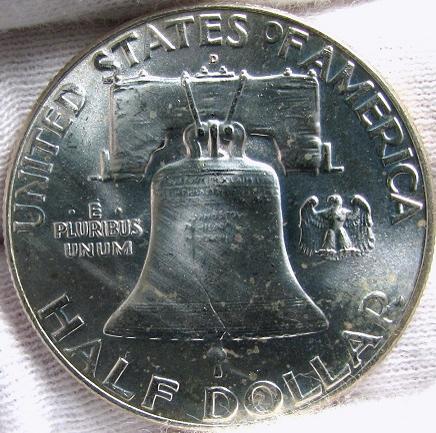
How many times have you found what you thought was a really great coin, only to have it return from PCGS, NGC, or even CAC, as “Wheel Mark” or “Counting Wheel Damage?” Many numismatists assume that a wheel mark is that circular scratch you sometimes see on pocket change (which are caused by coin wrapping machines), and so they completely miss the real culprit of this dreaded No-Grade label. A wheel mark is much more subtle, but insidious, as it affects numerous 20th Century coins, even some of those that have been certified as problem free. The actual cause is the rubber wheel of a counting machine. Instead of gripping the coin and flinging it through, the wheel catches and skids across the surface of a coin, leaving a patch of micro-scratches in its wake. This will look like a tightly formed series of fine hairlines.
Wheel marks can be extremely heavy or extremely light. Some coins will grade with mild wheel marks (especially if the graders miss them), and others do not have a prayer. Often, the mark will be square, rectangular, or even triangular, depending on how well the skidding wheel makes contact with the coin’s surface. These marks will often be caked with grease from the well-oiled machinery, creating a noticeable discoloration that can conceal the hairlines, just like toning. If you see a shape like this on a coin, you will now know to look carefully beneath it, tilting the coin at many angles (that’s how you look at a coin anyway, I hope), to make sure it’s not a wheel mark.
If a wheel-marked coin is brilliant, it will often come back from PCGS, NGC, and even CAC, as “Cleaned.” This can confuse the novice, and even the savvy numismatist, alike. The problem is that fully brilliant coins with a wheel mark will not show the tell-tale grease mark, but rather, only the hairlines, which can look quite a bit like cleaning hairlines. Sometimes it is simply easier for PCGS and NGC to label the coin as “Cleaned,” rather than make the final determination as to what caused these damaging hairlines. Of course, a “Cleaned” designation can be perplexing to someone who just pulled the coin out of a Mint Set, but about 10 times out of 9 (!), in this case, the culprit is a wheel mark. Regardless whether or not they used the right terminology to describe it on the label, the coin was rejected for a valid reason.
Sometimes PCGS and NGC will make the call to certify a mildly wheel-marked coin with a numerical grade, but CAC will later reject the coin due to the wheel mark. It must be understood that vast numbers of mid-20th Century coins have some degree of wheel mark on them from these terrible counting machines. And, because they vary in shape, size, color, and position, there is a great deal of subjectivity over how much of a mark is acceptable on a “problem-free” coin. Thus, the grading services can differ in their opinions.
It will behoove you to double-check all potential pick-ups, both raw and certified, to find those wheel marks before you make your purchases.
Doug
DM Rare Coins
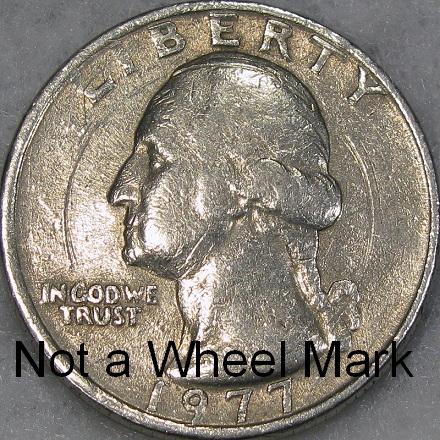
October 31, 2015
DM RARE COINS COIN OF THE MONTH!
October 2015
1970-S/S Prooflike Lincoln Cent
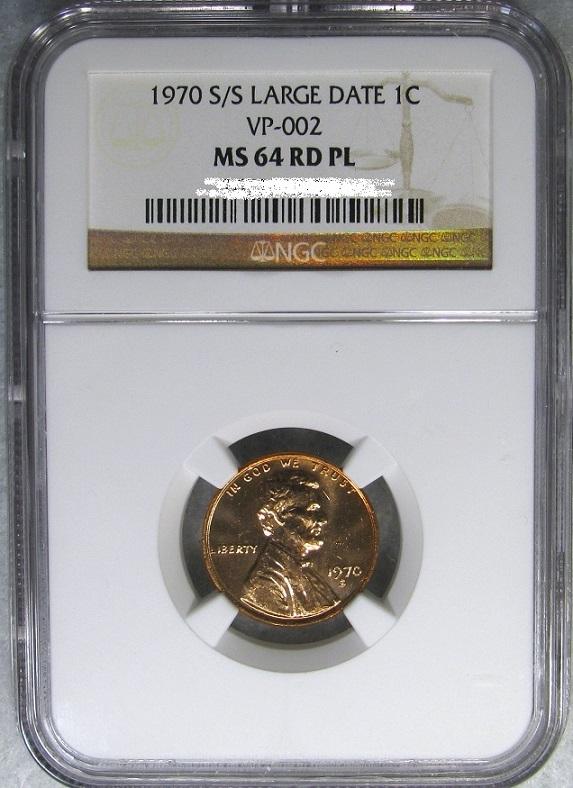
While this RPM is a fascinating die variety, which itself could have earned it a spot on Coin of the Month, the reason this piece was chosen is because of its deeply Prooflike surfaces. It takes a strong mirror-like finish to earn a Prooflike designation at NGC (PCGS does not use PL, outside of Morgan dollars and Modern commemoratives), and this 1970-S is the only Prooflike Lincoln cent certified between 1943 and 1987, and it is the only Prooflike Bronze Lincoln cent ever graded.
Prooflike Lincolns have always been elusive. Production began in 1909, replacing the Indian Cent. The typical finish of a Lincoln Wheat Cent, and also a Lincoln Memorial Cent, is a thick satiny matte texture. No Prooflike Lincoln Wheat Cents were made until a fluke in 1943, when a handful of Steel cents were produced from polished, Prooflike dies. NGC has certified just 10 of these 1943-S steel cents as Prooflike, to date.
The next instance of a Prooflike cent came some 27 years later, with this featured 1970-S/S, and it is presumed to be quite a rare find. Again, “deeply mirrored” is the opposite of what a Lincoln Cent typically looks like, and the coins of the 1960s and 1970s, in particular, are typically satiny and grainy in comparison to issues of the 1980s, when the composition changed to copper-plated zinc. Thus, a Prooflike 1970-S cent runs completely contrary to the norm. And, in regards to this specific die marriage, our analysis of multiple examples indicates that the mirrored surfaces eroded very quickly. First the reverse lost its reflectivity, then the obverse followed suit. Soon, both sides changed to a semi-glossy luster. The deep watery mirrors on the featured specimen indicate that it must have been among the first dozen or so strikes from new dies.
Until the discovery of this piece in 2015, no Prooflike cents were known between 1943 and 1987, and no bronze Prooflikes had ever been graded. In the latter year, the Mint began an overhaul of its quality control. The general quality of coinage had become extremely low; coins of the early to mid-1980s were typically struck with rough, uneven surfaces, from dies that were worn out. In 1987, however, the Mint began chrome plating dies, and this changed the appearance of the coinage drastically, lending the coinage a smooth, glossy sheen. The changes made Prooflike Lincoln cents, as well as Prooflike examples of other denominations, a more frequent occurrence. NGC has certified one 1987-P cent in Prooflike, as well as one 1988-P, one 1989-P, four 1989-D, and one more in 1990-P. Indeed, Prooflike cents have been popping up in small but regular numbers ever since; and today, while they are still a relatively scarce occurrence, one would not be taken aback to encounter a modern Prooflike Lincoln, as was the case with finding this bronze 1970-S/S.
Between the dates of 1909 and 1987, only 11 Prooflike Lincoln cents are currently known to exist. 10 of those are steel cents dated 1943-S; the 11th coin is this singular 1970-S/S RPM Lincoln Cent in bronze. It is truly a remarkable coin, not only because of the variety, but more so because its finish runs completely contrary to that seen in many decades of the Lincoln Cent series.
Doug
DM Rare Coins
October 21, 2015
Coin Collecting Is More Than Money
We recently helped an elderly, life-long coin collector divvy up his collection to split among his three grandchildren, now in their 30s. The collection was substantial, but the most interesting piece, in our opinion, as well as in that of the new owner, was a well-worn, low-grade, George V, British Penny. The grandson had actually given this very coin to the grandfather, almost 30 years prior. The grandfather saved and cataloged his collection so meticulously that this two dollar British penny could be provenance back to that fateful transaction, three decades prior. Not only was the rediscovery of this piece a sentimental moment for the grandson and the family, but it also demonstrates that part of the fun of collecting is not in the value of a coin, but in the relationships fostered through collecting, in the fun of putting together sets, and in keeping track of one’s progress with proper records.
The family told me they were fascinated by the ornate details on this coin, now over 100 years old, and even more shocked that it was only worth a few dollars, if that. I explained to them that these were saved in gem uncirculated condition, and some numismatists would even argue that the prices on those gems are rather weak in today’s world coin market. But I also suggested that this coin could be a gateway for the family to continue the rich legacy of coin collecting that the grandfather was passing down to them, but without the inconvenience of spending lots of money. I explained that this is a rare instance where you can put together a virtually complete set of old and very interesting coins—each piece for the price of a cup of coffee—and yet, each coin holds incredible history within (if only our coins could tell us where they’ve been). I had them going with this, until I suggested that the next logical step would be to collect older issues, perhaps by ruler, and that it would only be a matter of time until they wanted to collect some of the similar looking halfpence that circulated in colonial America. It’s amazing that the allegorical figure of Britannia has not changed much over the centuries (too much information for beginning collectors).
Fortunately, I also pointed out how convenient the grandfather’s diligence had proven to be, for all of us. Every coin was properly documented upon its accession into the collection, and splitting things up was in tern simplified. So many collectors have few or no records of their collections, and I wonder if some of them are missing out on the residual excitement that can come with the hobby. Simple documentation can help one appreciate the coins they already have, rather than exclusively relying on the thrill of the hunt for excitement. Over time, documenting can lead to researching, which can then lead to learning about the origin of coins, and how they ultimately came into being. Granted, not every collector can be a serious numismatist; but this collector was on his game, and his modest recording of information provided a priceless moment of intrigue and nostalgia for the family, 30 years later.
This is a reminder to collectors that sometimes the dollar value of a coin is irrelevant in terms of satisfying the collecting bug; and that a careful, thoughtful approach to collecting can create its own rewards down the road.
Doug
DM Rare Coins
